I Jornadas Internacionais de
Promoção do Turismo Cientifico e do
Património do Vale do Côa
Mêda (P), Abril
20-24, 2002
Section II : Iconography
& Symbolism in the Prehistoric & Protohistoric Cultures
Identificações
R & D
Da imagem de nós próprios
à assinatura
A
identificação escrita, a reconhecida
representação gráfica do individual
sapiens sapiens,
é o resultado de um longo processo de ... „R & D".
Surpreendentemente, quer a representação
figurativa como a icónica têm
sido usadas desde o nascimento das artes gráficas.
Mas a aceitação de "nomes
pessoais" tinha que esperar pela invenção da
escrita fonética.
Sugerimos que uma vez que alguém ousa representar
uma coisa por outra coisa, então,
a principal barreira mental para representar fonemas por
signos fica levantada.
O relevante processo genérico envolvido é a
redução de signos gráficos em
"elementos de repetição"
pré-fabricados,
ou grafemas, prontos a serem reunidos de
vários modos.
A nossa demonstração será focada em
duas letras com caracteres antropomórficos: o "R & D", ou seja "Rosto
e Dedos".
ID's
R & D :
from the image of ourself to
signature
A psychologist from Aberdeen, Jan Deregowski has
been the first Rock Art researcher to acknowledge that the perceptual
aspect of the task of depiction is a process of
the eye-brain system, therefore a
process occurring in, what is suited to call, a normal
state of consciousness. DEREGOWSKI has introduced the concept of "typical contour",
i.e: one selects the most
useful elements for the recognition of the model; each element being
represented under its most characteristic or unusual angle. Open-Air
Rock Art in the Guadiana and the Douro basins offers numerous
illustrations of Palaeolithic "typical contour".
e.g.: the finely carved Toro of Cheles (Spain):
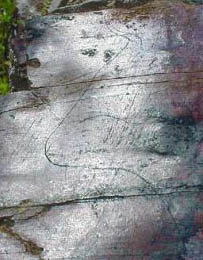
The typical contour of the horns being not coplanar with the dominant
typical contour of the bull gives rise to a twisted drawing.
Orthogonal view angles give rise to an even more dramatic effect such
as in the engraved bovid of Canada do Inferno (Portugal).
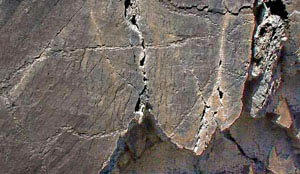
In those early days, in the absence of a sufficient language for a
satisfactory oral expression,
sapiens sapiens might have found in Rock Art a stimulating activity to
"format" his brain.
In order to "express his magical vision of the world", sapiens sapiens
had little choice other than to excel in Rock Art.
By the end of Neolithic era, such a privilege role of a particular mode
of expression will no longer hold :
orality became more competitive, and a
new competitor to Rock Art emerged: ceramic.
Examples of Palaeolithic typical contour of human beings are not so
common as those of animals. Fortunately, photographic illustrations of
two of them, recently found in the Cave of Cussac, in France, were part of a
press release of the Centre National de la Préhistoire.
|
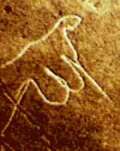
A.Nurturing sapiens |
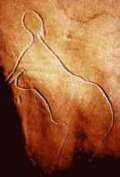
B.The First Lady |
The
mouth
As shown in Fig. A &
B, only a few strokes, engraved 30'000 years ago in
Cussac, suffice to characterize females. Noteworthy, those Gravettian
images of sapiens sapiens are faceless and mute.
Why ? It might be that the social acceptance of the individual
identity is a recent event, maybe bound to the invention of
phonetic writing. In Roman times, we know that only the gent
name was attributed to women. Even today, the mimetic
anonymity of the social role often supersedes individual names, e.g.:
numerous grown-up children are naming their parents Mom & Dad.
In other words, what is depicted in Cussac might be only a social
function: NOT individual women, but the ideal nurturing mother.
After those figurative representations of human female, let us turn to
her iconic representations. One of the very first icons has been the
pubic triangle. It is in the Chauvet cave, in the French department of
Ardèche, that the team of Jean Clottes has found a fine
example of this early iconic female representation. Fig.
C shows a rough engraving of the pure iconic sign.
Standing alone, this icon evokes, without ambiguities,
sapiens sapiens of female gender.
15'000 years later, during the Magdalenian period, appeared
as shown in Fig. D, one of the most
delicately sculptured pubic
triangle, on the Frise Bourdois at
Angles-sur-Anglin / F.
With a further jump,
by 8'000 years, into the Chalcolithic Era, Rock Art does
appear more skeletal compared with the sensual
images of the Magdalenian Era. The engraved piece of marble (3 cm long)
shown in Fig. E has been found in
Portugal. Another
Chalcolithic example is the mouthless idol on the stele found in
Miandassa" in Italy, see Fig. F. Among
the attributes of this idol, Dario Seglie has pointed out the pubic
triangle and the three cupmarks depicting the nipples and umbilicus.
This idol has several similarities with statue-menhirs, except that
here the pubic triangle is still depicted.
By the end of the Neolithic
Era, selected graphical signs appeared as reduced into prefabricated
"repeat-elements" or graphemes, ready to be
assembled in various ways. In the "radiography-like" pictures of insect
women, in Helanshan, see Fig. G
& H, the pubic triangle icon is
used as a dominant attribute of this composed figure.
Later,
the pubic triangle icon has been taken over in Sumer in order to become
the cuneiform ideogram for "woman" or "female", not carved with a
graver, but imprinted into a tablet of soft clay with the wedge of a
Reed stylus. As shown in Fig.
I, the Acadian word-sign "woman" was developed from a
straight line approximation and rotation over 90 degrees from the pubic
triangle. In Fig. J, the
cuneiform grapheme (the wedge) is substituted to each of the four
strokes of the pubic triangle icon.
Votive
stelae of Carthage are providing most perfect examples of the in-formatical
mutation, where a graphical sign is reduced to a grapheme ready to be
assembled in various ways in order to represent another
object than the original one. Fig. K
shows a mouthless face built-up with two graphemes: for the nose, the
triangular sign of the Goddess Tanit
and, for the eyes, twice the sign of the couple moon-sun. If the
Acadians have used the triangular icon for their ideogram "female", the
satellite picture of the Nile's Delta,
see Fig. L, reminds us that, the symbolic
meaning of mouth has even been extended to rivers, as testified in
various languages, e.g.: one speaks of les bouches
du Rhône, in France, of Swakopmund,
in (the former German colony of) Namibia, or of a desembocadura
do Tejo, in Portugal. Should one dare to conjecture that the
consonantal skeleton "dlt" had its origin in an ancient
language with the meaning of "mouth" ? What is sure is that the
anthropomorphic triangular icon might be considered as the graphical
prototype of the Latin letter
D, and that it lost its original meaning of mouth to get the phonetic
value attributed to the hand. Let us now turn our
attention to the avatars of the hand-icon.
|

C. Iconic sapiens |

D. Magdalenian |
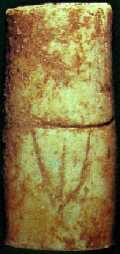
E. Chalcolithic icon |

F. Miandassa idol |
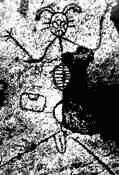
G. Radiographic |
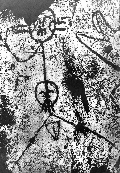
H.Therianthrope |

I. Rotating pubic triangle |

J. Female in cuneiform |
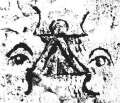
K. Goddess Tanit
as grapheme |

L. Nile's mouth |

M. Stamped hands
|

N. Stenciled hand |
The
hand
At
the Chauvet cave, see Fig. M, in those
early examples of "positive" hand-prints, the coloured "right" hand has
been used as a stamp against the wall. The "page setting" of
those hands reflects a prototype organisation of the mental thought.
The meaning of this ludo-pictorial message might be "I
imprint the traces of my hand, therefore I do exist", after
all, the technique of digital print is still used nowadays as a kind of
signature.
Not much later than the invention of this printing process appeared
another one: the blow printing with stencils. The example shown in Fig.
N, is from the Chauvet cave. This reproduction method
allows the printing of the so-called "negative" hands. The graphical
perfection of hand-icons produced with this method is such that one
might guess that it has inhibited the development of the figurative
representation of hands in painting.
A recurrent example of the
perenniality of the stencil printing process could be the tag shown in Fig.
O on a wall near the Castello San Jorge in Lisboa. This
left-hand-grapheme seems to be used here as a kind of "quality label".
On another wall, near the Polytechnic Institute of Lisboa, see Fig.
P, the sole addition of the tag Palavras brings,
in our opinion, a tone of sharp scepticism toward the idyllic charm of
the first tag.
The difficulty to interpret correctly this icon of today sheds of
course a gloomy light on our abilities to interpret icons produced
30'000 years ago.
In Chalcolithic age, appeared statues-menhir
with intriguing representations of the
hand. On the one found in Saint-Sernin, in France, a grapheme
made of parallel "digital" strokes represents the scarifications of the
face, see Fig. Q. This face has no
mouth. Remarkable is the secondary face on this
monument, see Fig. R. It is
sketched by the breasts, the Y-shaped pendant (an attribute which might
be considered as a substitute to the pubic triangle icon ?), and the
hand whose fingers strangely remind the scarification grapheme of the
head face. This replica of the face is as mute as the original. This
absence of mouth on early statue menhirs seems to testify that orality,
or should one say "the verb", has not been
sacralized until Bronze Age. Maybe the spoken language was
still too crude to be represented, and the message remained a "short
memo" of the mute transactions between human and goddesses. By
the way, one should notice the typical contour of the feet
in Fig. Q.
They are drawn as a straight extension of the open legs.
Such a typical contour calls for one of the
favourite examples of Jan Deregowski. Fig. S
shows Saint Mark and his acolytes on a 17th century Ethiopian
manuscript. Fig.T shows a blow-up of the
iconic feet of Saint Mark. Those feet are depicted here in an even more
twisted way than the ones depicted onto the statue-menhirs.
The technique of engraving
for figurative representation of the hand was not popular before the
Neolithic era. In Helanshan, in Northern China, it is the left
hand which has been used as a model, see Fig. U.
The details of the fingers of the hand disappear in hieroglyphic
engravings, see Fig V while in Carthage,
see Fig. W, the iconic hand demonstrates
how effective is the interchange of graphemes. Once
one dares to represent something by something else, the main mental
barrier to represent phonemes by signs is
lifted. After the mastering of the representation of an object by
another one, selected "graphemes" have been substituted to spoken
sounds.
In
Pharaonic Egypt, the commercial transactions have led to code the oral,
i.e.: to code the names of the trade partners (men or gods). While both
figurative & iconic representations
have been used in parallel since Palaeolithic ages, both
pictograms & phonograms
have been used in parallel in ancient Egypt.
A well proven process for the formation of some alphabetic signs is the
so-called acrophonic principle: one substitutes to
the complete name of an object its first "letter". The
phoneme is born out of the grapheme. As discovered in royal
cartouches by Champollion, the grapheme lion, lou
in Egyptian, has been used to represent the phonetic value "L". In a same way, the hieroglyph depicting a
mouth (or face), "rosh" in Semitic,
„rosto" in Portuguese, took the phonetic value "R". The hieroglyph depicting a
"hand", say "det" in semitic, took,
according to the acrophonic principle, the phonetic value "D", though, as we have seen, the graphical
sign had originally another meaning. The zoomorphic letter L and the
anthropomorphic letters R & D appear in the royal cartouches of
Alexander the Great, see
Fig. X, and of Queen Cleopatra "Qliopadra", see Fig.
Y. While one says Alexander, one says
Cleopatra,
because the "d" slipped toward "t" at the Ptolemaic times.
The social acceptance toward individuals to have
their own proper name, has first been granted to the most powerful
persons, and probably, those proto-individuals were also habilitated to
have their own feelings and their own dreams. In fact, their dreams
are the first relevant testimonies we have of how the language
structures our way of thinking. In the case of
Alexander, Plutarch reported the following poliorcetical
dream : In 332 BCE, after having besieged Tyre for seven
months, ALEXANDER the Great decided one
day to raise the siege. He believed he had lost all chances.
Nevertheless, during the following night he dreamt he chase a "satyr"
around a fountain. The next morning his counsellor explained to him:
"sa", in Greek it means "to you", and "tyr", means. "Tyre
will be yours". Indeed, after having dared to dream
his victory, he came into Tyre without resistance from the
besieged people who, after seven months, could endure no longer. The
choice of the symbols is of course depending of the structure of the
language, e.g.: Chinese, a language where the written form prevails
over the spoken one, will induce dreams
"unthinkable" in another language.
In short,
sapiens sapiens had to wait for the emergence of trade &
writing to have his first chance to develop an individuality
in the modern sense of the word, with an ID, not yet an ID-card of
course, but a proper name. Before this, only social roles
were relevant, and the spoken language was probably too crude to allow the
invention of narratives involving supernatural persons,
too crude to allow myths.
Léo DUBAL /
virtual laboratory for archaeometry / dubal (at)
archaeomety.org
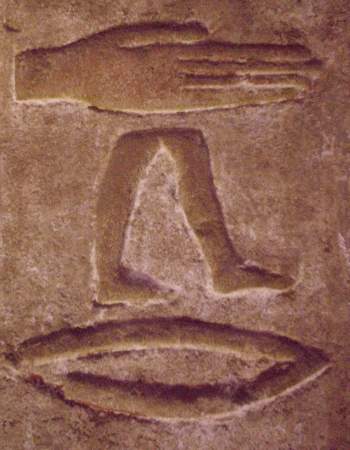
back
|

O. Lisboet tag
|

P. Composition |
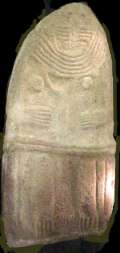
Q: Mute face |
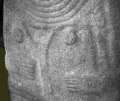
R.Secondary face? |
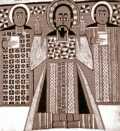
S. Ethiopian icon |

T. Typical contour |
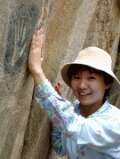
U. Engraved hand |

V. Egyptian hieroglyphs
|
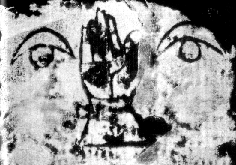
W. Punic composition with graphemes |

X. Alexander's cartouche |
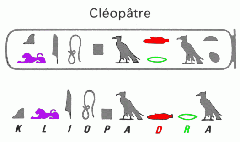
Y. Cleopatra's
cartouche |
|